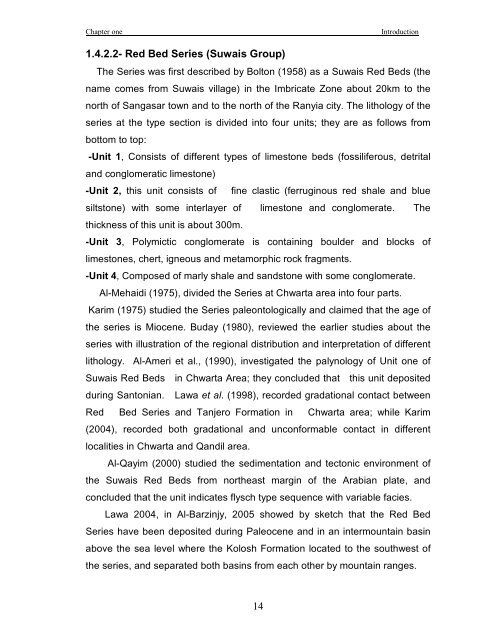biostratigraphy and paleoecology of cretaceous/tertiary boundary in ...
biostratigraphy and paleoecology of cretaceous/tertiary boundary in ...
biostratigraphy and paleoecology of cretaceous/tertiary boundary in ...
You also want an ePaper? Increase the reach of your titles
YUMPU automatically turns print PDFs into web optimized ePapers that Google loves.
Chapter one<br />
Introduction<br />
1.4.2.2- Red Bed Series (Suwais Group)<br />
The Series was first described by Bolton (1958) as a Suwais Red Beds (the<br />
name comes from Suwais village) <strong>in</strong> the Imbricate Zone about 20km to the<br />
north <strong>of</strong> Sangasar town <strong>and</strong> to the north <strong>of</strong> the Ranyia city. The lithology <strong>of</strong> the<br />
series at the type section is divided <strong>in</strong>to four units; they are as follows from<br />
bottom to top:<br />
-Unit 1, Consists <strong>of</strong> different types <strong>of</strong> limestone beds (fossiliferous, detrital<br />
<strong>and</strong> conglomeratic limestone)<br />
-Unit 2, this unit consists <strong>of</strong> f<strong>in</strong>e clastic (ferrug<strong>in</strong>ous red shale <strong>and</strong> blue<br />
siltstone) with some <strong>in</strong>terlayer <strong>of</strong> limestone <strong>and</strong> conglomerate. The<br />
thickness <strong>of</strong> this unit is about 300m.<br />
-Unit 3, Polymictic conglomerate is conta<strong>in</strong><strong>in</strong>g boulder <strong>and</strong> blocks <strong>of</strong><br />
limestones, chert, igneous <strong>and</strong> metamorphic rock fragments.<br />
-Unit 4, Composed <strong>of</strong> marly shale <strong>and</strong> s<strong>and</strong>stone with some conglomerate.<br />
Al-Mehaidi (1975), divided the Series at Chwarta area <strong>in</strong>to four parts.<br />
Karim (1975) studied the Series paleontologically <strong>and</strong> claimed that the age <strong>of</strong><br />
the series is Miocene. Buday (1980), reviewed the earlier studies about the<br />
series with illustration <strong>of</strong> the regional distribution <strong>and</strong> <strong>in</strong>terpretation <strong>of</strong> different<br />
lithology. Al-Ameri et al., (1990), <strong>in</strong>vestigated the palynology <strong>of</strong> Unit one <strong>of</strong><br />
Suwais Red Beds <strong>in</strong> Chwarta Area; they concluded that this unit deposited<br />
dur<strong>in</strong>g Santonian. Lawa et al. (1998), recorded gradational contact between<br />
Red Bed Series <strong>and</strong> Tanjero Formation <strong>in</strong> Chwarta area; while Karim<br />
(2004), recorded both gradational <strong>and</strong> unconformable contact <strong>in</strong> different<br />
localities <strong>in</strong> Chwarta <strong>and</strong> Q<strong>and</strong>il area.<br />
Al-Qayim (2000) studied the sedimentation <strong>and</strong> tectonic environment <strong>of</strong><br />
the Suwais Red Beds from northeast marg<strong>in</strong> <strong>of</strong> the Arabian plate, <strong>and</strong><br />
concluded that the unit <strong>in</strong>dicates flysch type sequence with variable facies.<br />
Lawa 2004, <strong>in</strong> Al-Barz<strong>in</strong>jy, 2005 showed by sketch that the Red Bed<br />
Series have been deposited dur<strong>in</strong>g Paleocene <strong>and</strong> <strong>in</strong> an <strong>in</strong>termounta<strong>in</strong> bas<strong>in</strong><br />
above the sea level where the Kolosh Formation located to the southwest <strong>of</strong><br />
the series, <strong>and</strong> separated both bas<strong>in</strong>s from each other by mounta<strong>in</strong> ranges.<br />
14

















